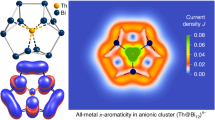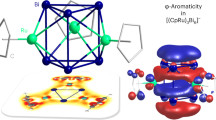Abstract
Atomic clusters often show unique, size-dependent properties and have become a fertile ground for the discovery of novel molecular structures and chemical bonding. Here we report an investigation of the B19− cluster, which shows chemical bonding reminiscent of that in [10]annulene (C10H10) and [6]circulene (C24H12). Photoelectron spectroscopy reveals a relatively simple spectrum for B19−, with a high electron-binding energy. Theoretical calculations show that the global minimum of B19− is a nearly circular planar structure with a central B6 pentagonal unit bonded to an outer B13 ring. Chemical bonding analyses reveal that the B19− cluster possesses a unique double π-aromaticity in two concentric π-systems, with two π-electrons delocalized over the central pentagonal B6 unit and another ten π-electrons responsible for the π-bonding between the central pentagonal unit and the outer ring. Such peculiar chemical bonding does not exist in organic compounds; it can only be found in atomic clusters.
This is a preview of subscription content, access via your institution
Access options
Subscribe to this journal
Receive 12 print issues and online access
$259.00 per year
only $21.58 per issue
Buy this article
- Purchase on Springer Link
- Instant access to full article PDF
Prices may be subject to local taxes which are calculated during checkout




Similar content being viewed by others
References
Minkin, V. I., Glukhovtsev, M. N. & Simkin, B. Y. Aromaticity and Antiaromaticity (Wiley, 1994).
Schleyer, P. v. R. (ed.) Special edition on delocalization pi and sigma. Chem. Rev. 105 (2005).
Schleyer, P. v. R. (ed.) Special edition on aromaticity. Chem. Rev. 101 (2001).
Masamune, S., Hojo, K., Hojo Kiyomi, Bigam, G. & Rabenstein, D. L. Geometry of [10]annulenes. J. Am. Chem. Soc. 93, 4966–4968 (1971).
Masamune, S. & Darby, N. [10]Annulenes and other (CH)10 hydrocarbons. Acc. Chem. Res. 5, 272–281 (1972).
King, R. A., Crawford, T. D., Stanton, J. F. & Schaefer, H. F. III. Conformations of [10]annulene: more bad news for density functional theory and second-order perturbation theory. J. Am. Chem. Soc. 121, 10788–10793 (1999).
Price, D. R. & Stanton, J. F. Computational study of [10]annulene NMR spectra. Org. Lett. 4, 2809–2811 (2002).
Li, X., Kuznetsov, A. E., Zhang, H. F., Boldyrev, A. I. & Wang, L. S. Observation of all-metal aromatic molecules. Science 291, 859–861 (2001).
Zhai, H. J., Alexandrova, A. N., Birch, K. A., Boldyrev, A. I. & Wang, L. S. Hepta- and octacoordinate boron in molecular wheels of eight- and nine-atom boron clusters: observation and confirmation. Angew. Chem. Int. Ed. 42, 6004–6008 (2003).
Zhai, H. J., Kiran, B., Li, J. & Wang, L. S. Hydrocarbon analogues of boron clusters – planarity, aromaticity and antiaromaticity. Nature Mater. 2, 827–833 (2003).
Alexandrova, A. N., Boldyrev, A. I., Zhai, H. J. & Wang, L. S. All-boron aromatic clusters as potential new inorganic ligands and building blocks in chemistry. Coord. Chem. Rev. 250, 2811–2866 (2006).
Zubarev, D. Yu. & Boldyrev, A. I. Comprehensive analysis of chemical bonding in boron clusters. J. Comput. Chem. 28, 251–268 (2007).
Fowler, J. E. & Ugalde, J. M. The curiously stable B13+ cluster and its neutral and anionic counterparts: the advantages of planarity. J. Phys. Chem. A 104, 397–403 (2000).
Mercero, J. M. & Ugalde, J. M. Sandwich-like complexes based on ‘all-metal’ (Al42−) aromatic compounds. J. Am. Chem. Soc. 126, 3380–3381 (2004).
Aihara, J. B13+ is highly aromatic. J. Phys. Chem. A 105, 5486–5489 (2001).
Fowler, P. W. & Gray, B. R. Induced currents and electron counting in aromatic boron wheels: B82− and B9−. Inorg. Chem. 46, 2892–2897 (2007).
Hanley, L. & Anderson, S. L. Production and collision-induced dissociation of small boron cluster ions. J. Phys. Chem. 91, 5161–5163 (1987).
Hanley, L., Whitten, J. L. & Anderson, S. L. Collision-induced dissociation and ab initio studies of boron cluster ions: determination of structures and stabilities. J. Phys. Chem. 92, 5803–5812 (1988).
Hintz, P. A., Ruatta, S. A. & Anderson, S. L. Interaction of boron cluster ions with water: single collision dynamics and sequential etching. J. Chem. Phys. 92, 292–303 (1990).
Hintz, P. A., Sowa, M. B., Ruatta, S. A. & Anderson, S. L. Reactions of boron cluster ions (Bn+n = 2–24) with N2O: NO versus NN bond activation as a function of size J. Chem. Phys. 94, 6446–6458 (1991).
Sowa-Resat, M. B., Smolanoff, J., Lapiki, A. & Anderson, S. L. Interaction of small boron cluster ions with HF. J. Chem. Phys. 106, 9511–9522 (1997).
Zhai, H. J., Wang, L. S., Alexandrova, A. N. & Boldyrev, A. I. Electronic structure and chemical bonding of B5− and B5 by photoelectron spectroscopy and ab initio calculations. J. Chem. Phys. 117, 7917–7924 (2002).
Alexandrova, A. N. et al. Structure and bonding in B6− and B6: planarity and antiaromaticity. J. Phys. Chem. A 107, 1359–1369 (2003).
Zhai, H. J., Wang, L. S., Alexandrova, A. N., Boldyrev, A. I. & Zakrzewski, V. G. Photoelectron spectroscopy and ab initio study of B3− and B4− anions and their neutrals. J. Phys. Chem. A 107, 9319–9328 (2003).
Kiran, B. et al. Planar-to-tubular structural transition in boron clusters: B20 as the embryo of single-walled boron nanotubes. Proc. Natl Acad. Sci. USA 102, 961–964 (2005).
Sergeeva, A. P., Zubarev, D. Yu., Zhai, H. J., Boldyrev, A. I. & Wang, L. S. A photoelectron spectroscopic and theoretical study of B16− and B162−: an all-boron naphthalene. J. Am. Chem. Soc. 130, 7244–7246 (2008).
Zubarev, D. Yu. & Boldyrev, A. I. Revealing intuitively assessable chemical bonding patterns in organic aromatic molecules via adaptive natural density partitioning. J. Org. Chem. 73, 9251–9258 (2008).
Wang, L. S., Cheng, H. S. & Fan, J. Photoelectron spectroscopy of size-selected transition metal clusters: Fen−, n = 3–24. J. Chem. Phys. 102, 9480–9493 (1995).
Saunders, M. Stochastic search for isomers on a quantum mechanical surface. J. Comput. Chem. 25, 621–626 (2004).
Wales, D. J. & Doye, J. P. K. Global optimization by basin-hopping and the lowest energy structures of Lennard–Jones clusters containing up to 110 atoms. J. Phys. Chem. A 101, 5111–5116 (1997).
Fujimori, M. et al. Peculiar covalent bonds in α-rhombohedral boron. Phys. Rev. Lett. 82, 4452–4455 (1999).
Oger, E. et al. Boron cluster cations: transition from planar to cylindrical structures. Angew. Chem. Int. Ed. 46, 8503–8506 (2007).
Zubarev, D. Yu. & Boldyrev, A. I. Developing paradigms of chemical bonding: adaptive natural density partitioning. Phys. Chem. Chem. Phys. 10, 5207–5217 (2008).
Schleyer, P. v. R., Maerker, C., Dransfeld, A., Jiao, H. J. & Hommes, N. J. R. V. Nucleus-independent chemical shifts: a simple and efficient aromaticity probe. J. Am. Chem. Soc. 118, 6317–6318 (1996).
Clar, E. The Aromatic Sextet (Wiley, 1972).
Frisch, M. J. et al. The Gaussian 03 program (revision D.01) (Gaussian, 2003).
Portmann, S. Molekel, Version 4.3 (Swiss National Supercomputing Centre/Swiss Federal Institute of Technology Zurich, 2002).
Acknowledgements
The experimental work was supported by the National Science Foundation (DMR-0904034). The basin-hopping search was performed with supercomputers at the EMSL Molecular Science Computing Facility, Pacific Northwest National Laboratory. The theoretical work done at Logan was supported by the National Science Foundation (CHE-0714851).
Author information
Authors and Affiliations
Contributions
H.J.Z. performed the experiment. W.H. carried out the basin-hopping global minimum search. B.B.A. performed the Coalescence Kick global minimum search. A.P.S. carried out the geometry optimization and frequency calculations of all the B19− isomers recovered by the basin-hopping and the Coalescence Kick global minimum searches, and the calculations of VDEs, molecular orbital chemical bonding analyses and the AdNDP chemical bonding analyses. The experiment was designed by L.S.W. The data analyses were done by A.P.S., W.H., L.S.W. and A.I.B. The manuscript was written by A.P.S., L.S.W. and A.I.B., and was commented on by all the authors. A.I.B. and L.S.W. contributed equally to the study.
Corresponding authors
Ethics declarations
Competing interests
The authors declare no competing financial interests.
Supplementary information
Supplementary information
Supplementary information (PDF 6314 kb)
Rights and permissions
About this article
Cite this article
Huang, W., Sergeeva, A., Zhai, HJ. et al. A concentric planar doubly π-aromatic B19− cluster. Nature Chem 2, 202–206 (2010). https://doi.org/10.1038/nchem.534
Received:
Accepted:
Published:
Issue Date:
DOI: https://doi.org/10.1038/nchem.534
This article is cited by
-
Exploring the Capabilities of Pristine B84 Nanocluster for Selective NO and N2O Gases Detection Involved to COVID-19: A DFT Analysis
Journal of Inorganic and Organometallic Polymers and Materials (2023)
-
Quasi-planar Co atom-doped boron cluster: CoB192−
Journal of Molecular Modeling (2023)
-
Planar Octacoordinate Aluminium in Dual Aromatic AlBe4N4− Cluster
Journal of Cluster Science (2023)
-
Structural evolution and electronic properties of germanium-doped boron clusters and their anions: GeBn0/− (n = 6–20)
Journal of Nanoparticle Research (2022)
-
Open questions in boron species with globally 4n π systems
Communications Chemistry (2021)



